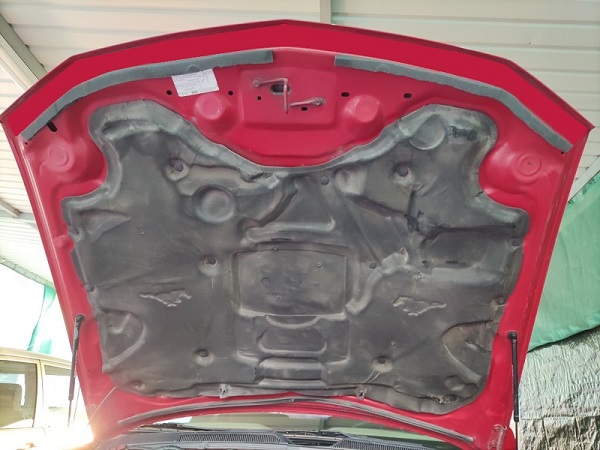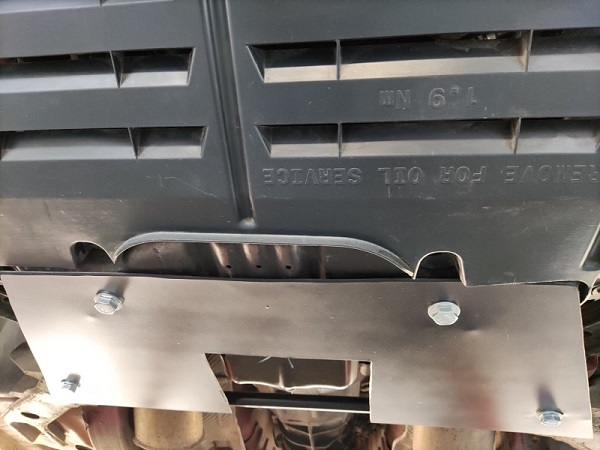Aerodynamics
Home | Intake | CMDP | UDP | Exhaust | Suspension | Interior | Aerodynamics | Parts | Dyno | Bolt Ons | Engine | Coyote SwapAerodynamically, the front of the car must be designed to get air moving over and under the car as smoothly as possible with minimal turbulence. In its attempt to give the S197 a retro look reminiscent of late-60's Mustang fastbacks, Ford went to great effort to provide a balance between looks and functionality to match the vehicle's performance and design goals. However a blunt front end, plus an untidy underbody with several turbulence-inducing protrusions, resulted in a poor drag coefficient of 0.380 by modern standards. On the 2010 model, Ford went some way towards streamlining the front underbody by installing a wider undertray and an engine splash shield, thereby reducing the drag coefficient by 7% to a more respectable 0.355. Nevertheless, I discovered that there was plenty of room for further improvement.
The 2005-2009 Mustang has a front undertray (Ford part no. 5R3Z-17626-BA) that's only slightly wider than the radiator and extends from the lower radiator support to the center portion of the front bumper cover. This leaves two large gaps between the side edges of the undertray and the left and right edges of the bumper cover. When the car is moving, air can become trapped in these pockets and create lift.
One solution is to swap in the wider front undertray from a 2010 Mustang (Ford part no. AR3Z-17626A) but that requires some trimming to fit properly and still leaves a small gap behind the center portion of the bumper cover. A cheaper alternative is to retain the 2005-2009 undertray but add extensions to each side to fill the gaps. I began by creating a cardboard template and then cut the required pieces from a scrap plastic fender liner. The pieces were attached to the existing undertray with self-tapping screws and the modified undertray was a perfect fit.
The next step was to retrofit the louvred engine splash shield from a 2010 Mustang (Ford part no. AR3Z-6C038A) to fill in the gap between the lower radiator support and the K-member. The splash shield fits directly without any modification using the supplied inserts/fixing screws, and can easily be removed when it's time to change the engine oil filter.
The photo on the right shows how the undertray and splash shield are positioned in relation to each other. The splash shield streamlines the flow path of air passing under the engine, while the louvres create an area of negative pressure that draws out hot air from behind the radiator to improve engine cooling at highway speeds. Hood flutter, common on 2005-2009 Mustangs at highway speeds, is reduced by preventing additional air from becoming trapped in the engine compartment. Highway fuel economy is also improved due to reduced drag.
 Hood Foam
Hood Foam
The 2005-2009 Mustang is notorious for experiencing hood flutter at highway speeds, especially when driving into a headwind. Even with the hood closed properly, the space between the hood and the radiator cover with extensions is wide enough to stick your fingers into! Adding some 1" thick polyurethane foam strips behind the leading edge of the hood seals this space and completely cures this problem. A small area was omitted in order to allow access to the hood latch.
 K-Member Undertray
K-Member Undertray
I completed the front underbody mods by fabricating a custom composite undertray that covers the trapezoid-shaped space created by the K-member. This streamlines airflow under the engine bay and reduces drag-inducing air trapping between the back of the engine and the firewall. The undertray includes a cutout to allow easy access to the sump bolt for engine oil changes, and extends backwards as far as the A-Arm brace.
Front Wheel Air Deflectors
 Air hitting the rotating wheels and fixed suspension components is spun into vortices inside the wheel houses, and accounts for as much as ~25% of a car's total aerodynamic drag. Deflecting some of that airflow away from the wheel houses reduces both aerodynamic lift and drag, improving high speed stability and fuel economy. I fabricated a pair of curved plastic air deflectors that are 8cm high and cover the whole width of each front wheel house, leaving 10cm of ground clearance. These are screwed onto the undertray extensions that I'd made previously and are easily removable if they are ever damaged on a curb.
Air hitting the rotating wheels and fixed suspension components is spun into vortices inside the wheel houses, and accounts for as much as ~25% of a car's total aerodynamic drag. Deflecting some of that airflow away from the wheel houses reduces both aerodynamic lift and drag, improving high speed stability and fuel economy. I fabricated a pair of curved plastic air deflectors that are 8cm high and cover the whole width of each front wheel house, leaving 10cm of ground clearance. These are screwed onto the undertray extensions that I'd made previously and are easily removable if they are ever damaged on a curb.
Rear Diffuser
At the rear, there's a large gap between the evaporative canister assembly and the bumper cover where air can be trapped like a parachute as road speed increases. Aftermarket rear diffusers are available but they're expensive, especially the carbon fibre versions. I took the DIY route by fabricating a simple plastic undertray that fills the gap and streamlines airflow out from the rear of the car.
